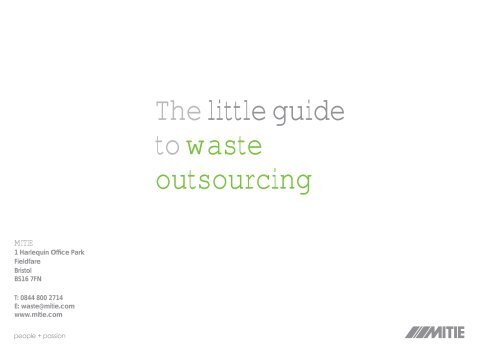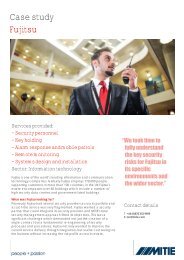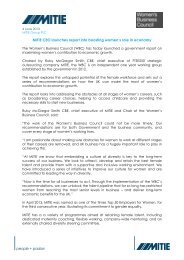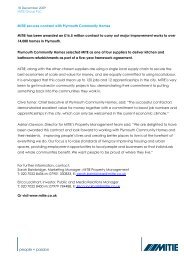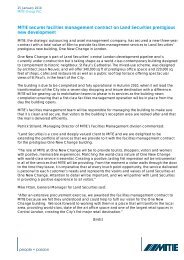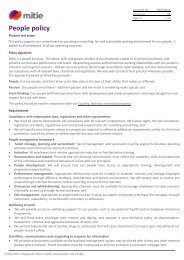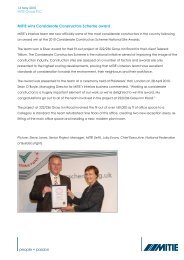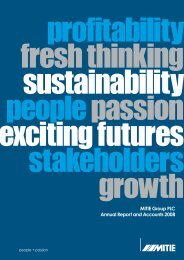MITIE Little Guide to Waste Outsourcing
MITIE Little Guide to Waste Outsourcing
MITIE Little Guide to Waste Outsourcing
- No tags were found...
You also want an ePaper? Increase the reach of your titles
YUMPU automatically turns print PDFs into web optimized ePapers that Google loves.
The little guide<strong>to</strong> wasteoutsourcing<strong>MITIE</strong>1 Harlequin Office ParkFieldfareBris<strong>to</strong>lBS16 7FNT: 0844 800 2714E: waste@mitie.comwww.mitie.com
Contents01 Foreword02 The world of waste management04 Welcome <strong>to</strong> <strong>MITIE</strong>08 Why outsourcing?10 What ‘good’ looks like13 Drivers of change14 Sustainability - it’s good for business16 Reducing your compliance risk18 Your duty of care20 Knowing the risk31 <strong>Waste</strong> streams32 The hunt for general waste34 <strong>Waste</strong> stream trump cards45 Recovery and disposal46 Why Zero <strong>Waste</strong>?48 The waste hierarchy in practice50 Recycling52 Commercial composting54 Anaerobic digestion56 Gasification and pyrolysis58 Landfill61 Thought leadership62 Controlling the cost of waste disposal64 What really comes out of your office?66 To compact or not <strong>to</strong> compact?68 Reduce, reuse, recycle - a change of focus is overdue71 Glossary and Contacts72 Glossary78 Contact usForewordWhen <strong>MITIE</strong> first started <strong>to</strong>trade over twenty years ago,waste disposal was part of thegeneral outsourcing offering,with the odd recycling reportand of course the manda<strong>to</strong>rywaste transfer note.Looking back, there is a certain fondness felt at the sheer focus onservice and value, which gave the relationship between <strong>MITIE</strong> andour clients an impression of simplicity .Nowadays, in an effort <strong>to</strong> achieve a greener and cleaner future,organisations are subject <strong>to</strong> legislative, ethical, financial and qualityrelated variables that have turned the function of waste disposal in<strong>to</strong>an industry with a lot of complexities.For <strong>MITIE</strong>, managing this complicated network for our clients meanswe now employ over 80 waste management professionals, with adiverse range of expertise, who work as one <strong>to</strong> provide you with asingle sustainable partner.With this book, our desire is <strong>to</strong> offer some clarity on sustainable wastemanagement as you seek environmental and financial surety.We hope that this guide supports you in developing yourorganisation’s waste strategies and offers a point of reference <strong>to</strong>achieve environmental sustainability.Martyn Freeman, Managing Direc<strong>to</strong>r, <strong>MITIE</strong> Facilities Management
The world of waste management55.8m <strong>to</strong>nnesCommercial and industrial waste“We need a new approach<strong>to</strong> waste; one which worksfor the new economy”Caroline Spelman, Secretary of StateEuropeanDirectives9 Zero650 Treatmenttechnologiesover3,000UK contrac<strong>to</strong>rs533%*Landfill tax rising by* Landfill tax rise calculated from 2004 <strong>to</strong> 2014; from £15 <strong>to</strong> £80 per <strong>to</strong>nne120 wasteDifferentcontainers<strong>Waste</strong>853Classifiedwaste streams
Welcome <strong>to</strong> <strong>MITIE</strong>a sustainable businessWe specialise in wasteoutsourcing.And we like <strong>to</strong> thinkwe’re the best.We work in close partnershipwith each client <strong>to</strong> provideeverythingfrom strategic consultancy<strong>to</strong> sustainable wastemanagement.In simple terms,we think,we manage andwe deliver on your behalf.The value of being more sustainableis in gaining public trust.A mature waste ethos will go a long wayin building your sustainability credentialswith your stakeholders.The existing perception ofsustainable waste managements<strong>to</strong>ps at maximum recyclingand waste <strong>to</strong> energy initiatives.We have the resources and capability <strong>to</strong> go beyondall existing expectations and actually achieveZero <strong>Waste</strong>.
Welcome <strong>to</strong> <strong>MITIE</strong>your benefitsCredibility and reputationThe value of being more sustainable results in an increase in trust fromthe public. This in turn fosters loyalty and improves brand image.<strong>Waste</strong> sustainabilityBeing sustainable is not asstraightforward as it appears.Sustainability requires longterm thinking. Half of Britishorganisations recognise thatsustainable growth is critical <strong>to</strong>their continued success. <strong>Waste</strong>sustainability looks at materialefficiency and how it affectsthe day <strong>to</strong> day operations.Achieving Zero <strong>Waste</strong> is thecritical objective for anysustainable business.Collaborative partnershipThe sustainability approachrequires investment in<strong>to</strong>technologies and expertise,alongside detailed knowledgeof waste management.<strong>Outsourcing</strong> enables acollaborative partnershipwith access <strong>to</strong> expertsin sustainable wastemanagement, deliveringfresh thinking and new ideas,making your organisationmore innovative and efficient.Sustainability also affects recruitment and staff retention, as morepeople look at an organisation’s sustainability credentials beforejoining.EfficiencyA sustainable waste strategy looksat ways <strong>to</strong> minimise waste andcreates efficiency savings acrossthe organisation and its supplychain. Zero <strong>Waste</strong> is the ultimateefficiency status.Cost control and risk reductionBy pro-actively managing yourwaste streams, you gain control ofassociated costs. You also lowerthe risks that originate from a lackof knowledge of the legislation.
Why outsourcing?General waste service A recycling service <strong>Waste</strong>-<strong>to</strong>-energy A sustainabilitystrategyComprehensivewaste best practiceStrategic outsourcingIn the past, thedisposal of waste waslightly regulated, withorganisations havinglittle awareness of theirown effects on theenvironment. Typically,nearly all waste streamswould be disposed ofas general waste andNowadays, general wasteis the residual waste that isnot recycled.The start of thesustainability journey startshere. Most organisationshave put in place ascheme <strong>to</strong> recycle themost common wastestreams, like paper,plastics or food waste.value (CV) of some ofits components, generalwaste can be partly<strong>to</strong> provide fuel forwaste-<strong>to</strong>-energy plants.This can also be true ofsome recycling streamswith high CV (paper,plastics…).Sustainability is goodfor business so mos<strong>to</strong>rganisations havenow published theirsustainability strategy,as part of their corporateresponsibility.<strong>Waste</strong> may or maynot play a key partin demonstratingthe organisation’ssustainable objectives.Best practice aims <strong>to</strong>generate Zero <strong>Waste</strong>when possible and divertall residual waste streamsIt works by applyingThe 3 R’s (Reduce ReuseRecycle) at all levels inthe organisation and withits supply chain partners.Best practice is reportedthrough a comprehensiveenvironmental informationmanagement system.Access <strong>to</strong> leadingindependent expertsin sustainable wastemanagement enablesthe design and theimplementation of asuccessful strategy <strong>to</strong>achieve environmentalbest practice, now and foryears <strong>to</strong> come.<strong>MITIE</strong> works with a range of clients from all sec<strong>to</strong>rs all at different stages in their sustainability journeyTraditional 20th Centurywaste procurement strategy21st Century strategicenvironmental outsourcing
What ‘good’ looks like<strong>Waste</strong>sustainabilityFinancialgovernanceSustainabilityIndustrybest practiseInnovativethinkingIndustryleadingexpertsCost controlCredibility& reputationClient<strong>MITIE</strong>BenefitsResourceefficiencyRiskSustainablewastemanagementSustainabilityreportingEfficiencyCollaborativepartnershipSupply chainmanagementRisk reduction
SustainIT givesyou online access <strong>to</strong>management information24/7.Drivers for change“Can you affordnot <strong>to</strong> think aboutsustainability?”This means you can getyour waste data at a timethat suits you.Drivers for change14 Sustainability - It’s good for business16 Reducing your compliance risk18 Your duty of care20 Knowing the risk
014 Drivers for changeSustainability:it’s good for businessThe move <strong>to</strong>wards sustainability goes back as far as the 1950s,with the introduction of the Clean Air Act 1956, but our collectiveenvironmental consciousness really began <strong>to</strong> emerge in the 1970s,as this was the decade Greenpeace and Friends of the Earth startedspringing up world wide.In the 1980s, there was a significant gap between what the publicexpected of business and what business was actually doing in termsof the environment and green claims were more often than not, just‘green wash’, as products didn’t follow through on the environmentalbenefits or meet cus<strong>to</strong>mer expectations.Since then, many businesses have made significant improvements<strong>to</strong>wards more sustainable business practices. More and morebusinesses are making significant investments <strong>to</strong> make theirbusiness operations more sustainable and are formally reportingand publishing the steps they’re taking and the progress they’vemade.What is sustainability?Richard Ellis defines sustainability as “organisations doing the ‘right’thing throughout their operations for consumers and employees.”For many businesses, it’s about the 3 Ps – People, Planet and Profit- also known as “Triple Bot<strong>to</strong>m Line”. The 3Ps are an expandedspectrum of values and criteria for measuring organisationalsuccess.The concept demands that a business’ responsibility lies with itsstakeholders (anyone that is influenced either directly or indirectlyby its actions), rather than its shareholders.015 Drivers for changeWhy is this good for business?The connection betweensustainability and businesssuccess has long beenresearched and reported on. Arecent study showed that halfof all British businesses believethat improving their sustainabilitycredentials and actions is critical<strong>to</strong> their continued success.This area of focus has stronglinks with a company’s costprofile due <strong>to</strong> the connectionwith resource use, wastemanagement costs andregula<strong>to</strong>ry compliance.Hewlett Packard has shown thata strategic approach <strong>to</strong> businesssustainability does havea significant and positive impac<strong>to</strong>n environmental performance.Between 2008 and 2009, theirenergy consumption went downby 9%, they recovered 112,000<strong>to</strong>nnes of electronic productsand they purchased 131 millionKwH of renewable energy (seeHP’s Global Citizenship Report2009).This leads <strong>to</strong> operationalefficiency, reduced costs,increased revenue, access<strong>to</strong> capital, more effective riskmanagement- all of whichincreases shareholder value.The real question is canyou afford not <strong>to</strong> thinkabout sustainability?
016 Drivers for changeReducing your compliance riskEnvironmental legislation is complex and constantlyevolving, with national and European laws affectingthe way in which organisations operate.In recent years, fiscal and economic measures have beenintroduced <strong>to</strong> make the polluter pay and <strong>to</strong> bring about a reductionin carbon emissions.<strong>Waste</strong> management legislation in the UK originates from the Controlof Pollution Act 1974. Then, in 1990 national controls were tightenedwith the introduction of the Environmental Protection Act.Across Europe, waste management legislation is derived from theEU <strong>Waste</strong> Framework Directive (European Directive 75/442/EC asamended).The directive specifies that all EU member states have <strong>to</strong> ensurethat waste is recovered or disposed of without harm <strong>to</strong> humanhealth or the environment. It aims <strong>to</strong> control the keeping, transportand treatment, deposit and disposal of waste. It covers permitting,registration and inspection requirements.It affects the waste management industry including s<strong>to</strong>rage,registration, licensing, moni<strong>to</strong>ring and record keeping. It also coversspecific waste streams like clinical and hazardous wastes.There are a significant number of EU directives and nationalregulations that are relevant <strong>to</strong> waste management. To addfurther complication, some UK regulations have been adoptedand adapted by the devolved administrations of Northern Ireland,Scotland and Wales.017 Drivers for changeIn short:All EU and UK waste legislationcomes down <strong>to</strong> the following:a. segregate your waste;b. measure your waste;c. manage your wasteappropriately and safely;d. keep a record of whathappens <strong>to</strong> your waste;e. check that your wastecontrac<strong>to</strong>rs are doing what theysay they are doing with yourwaste.European Union definitions<strong>Waste</strong>:Any substance or object whichthe holder discards, intends, or isrequired <strong>to</strong> discard.Producer:Anyone whose activitiesproduce waste or anyone whocarries out pre-processing,mixing or other operationsresulting in a change in nature orcomposition of waste.
018 Drivers for changeYour duty of careDuty of care regulations have a foundation in theEnvironmental Protection Act 1990 and apply <strong>to</strong>anyone handling waste - from the person thatproduces it <strong>to</strong> the person who finally disposes orrecovers it.Scenario:After eight years working from home, a man sets up an office inrented accommodation. He receives the waste disposal businessrate details from his local council and is unsure what’s the best way<strong>to</strong> deal with his office waste. Rates do not include emptying thebins.He recycles as much as he can in terms of re-using paper, onlyprinting what he needs and has little waste - approximately one binbag each month with little or no plastic.Legally, he can’t take it home <strong>to</strong> mix it with his household waste andhe has <strong>to</strong> either employ the local authority or another contrac<strong>to</strong>r <strong>to</strong>collect it, or take it <strong>to</strong> a waste reception centre and get a receipt(waste transfer note).Total amount of fines£2.2mIn 2009, the Environment Agencyissued £2,288,704 in fines forwaste crimes.All businesses have a duty of care under the EnvironmentalProtection Act 1990 <strong>to</strong> take all reasonable steps <strong>to</strong> ensure thelegal disposal of their waste.You are legally responsible for ensuring that the waste yourbusiness produces or handles is s<strong>to</strong>red, treated, reprocessedand disposed of safely. This is your duty of care.Defra provide a code of practice on their website.The Environment Agency (details in the contacts section) hashad approval for funding <strong>to</strong> roll out an internet based dutyof care system <strong>to</strong> allow businesses <strong>to</strong> record waste transferselectronically. The scheme will be implemented in 2012 and isexpected <strong>to</strong> be fully rolled out by 2015.
020 Drivers for changeKnowing the risk: WEEE(waste electrical and electronic equipment)It’s estimated that one million <strong>to</strong>nnes of electricaland electronic waste is generated in the UK byhouseholds and businesses.Scenario:A small IT company has a large number of computers that are nolonger needed. The hard drives have been removed ready forwiping but the company needs <strong>to</strong> dispose of all the metal casingsand cabinets.Taking the metal waste <strong>to</strong> a civic amenity site is not an option as it’scommercial waste.The cases, which still contain much of the computer technology,need <strong>to</strong> be treated as WEEE. If the volumes are sufficiently large, thecompany will need an appropriate license <strong>to</strong> dispose of them, or <strong>to</strong>contract a licensed waste contrac<strong>to</strong>r.There have been many incidences where WEEE has beendiscovered in shipping containers at ports in foreign countries. If anyWEEE is traced <strong>to</strong> your business, you’re liable for improper disposal.WEEE relates <strong>to</strong> anything that has a primary function that iselectrical or electronic.For example, because a television requires electricity <strong>to</strong>function, it’s covered by WEEE regulations. On the contrary,musical greetings cards are not covered because theirprimary function (greetings) does not require electricity.Some WEEE may also be covered by the Hazardous <strong>Waste</strong>Regulations (or the Special <strong>Waste</strong> Regulations in Scotland.For further information, please visit the Environment Agencywebsite.Recyclable content80%There are 90 million redundantmobile phones in the UK.
022 Drivers for changeKnowing the risk: hazardous wasteMore than 6.6 million <strong>to</strong>nnes of hazardous waste(known as special waste in Scotland) were generatedin 2008 of which approximately 1.1 million <strong>to</strong>nnes hadbeen re-used or recycled.Scenarios:A local builder put a load of damaged fluorescent tubes in<strong>to</strong> a skipthat he has hired for a job. When it came <strong>to</strong> paying for the skip, theskip hire company charged him for the skip that he had plus anotherone <strong>to</strong> put the tubes in because its hazardous nature requires aspecific consignment note.A nail beauty specialist operates a mobile salon service - visitingclients in their homes or having clients come <strong>to</strong> her home <strong>to</strong> get theirnails done. A client appointment often results in the use of chemicalssuch as ace<strong>to</strong>ne and monomer, which have <strong>to</strong> be disposed oflegally as trade waste, subject <strong>to</strong> the hazardous waste legislation.Hazardous waste is waste that’s considered harmful <strong>to</strong>human health or the environment. It now includes televisions,computer moni<strong>to</strong>rs (both of which are also covered by WEEE),fluorescent tubes and end-of-life vehicles.Other examples of hazardous waste include:- Healthcare and clinical wastes- Solvents and chemicals- Oils and sludgesThe Environment Agency has published guidance on whathazardous waste is and how <strong>to</strong> deal with it.Recovery Rate16%Hazardous waste is waste that’sconsidered harmful <strong>to</strong> humanhealth and the environment.
024 Drivers for changeKnowing the risk: packagingThe UK Government target for packaging recoveryin 2009 was exceeded by more than 6%. Packagingwaste includes plastic, wood, paper, card and metal.Scenario:A chain of local s<strong>to</strong>res supplied by UK wholesalers, sells products <strong>to</strong>consumers. These products come in plastic, wood, paper, card andmetal containers and make up a <strong>to</strong>tal weight of over 50 <strong>to</strong>nnes peryear.As a producer of packaging waste, this business needs <strong>to</strong> registerwith the Environmental Agency (or the Scottish EnvironmentalAgency) or join a packaging compliance scheme.Packaging is anything that’s used <strong>to</strong> contain, protect, deliveror present goods. Goods could be raw materials or processeditems.If an item is integrated in<strong>to</strong> packaging and intended <strong>to</strong>be used and thrown away with it, it’s still considered aspackaging. For example, a makeup mascara brush or ameasuring cup provided with washing powder.Businesses that produce packaged goods, design orspecify packaging, import, sell or place on the market anypackaged goods or filled packaging will need <strong>to</strong> comply withthe Essential Requirements Regulations.Businesses handling more than 50 <strong>to</strong>nnes of packaging a yearand have a turnover of more than £2 million, will also need <strong>to</strong>comply with the Producer Responsibility Obligations.Tonnage11mThe UK disposed of 11 million<strong>to</strong>nnes of packaging waste ofwhich 65% was recovered.
026 Drivers for changeKnowing the risk: batteriesIt’s estimated that 30,000 <strong>to</strong>nnes of batteriesenter the UK market each year in products such as<strong>to</strong>rches, mobile phones, cameras and other portableelectrical devices.Scenarios:A DIY supers<strong>to</strong>re sells a range of battery operated products, as wellas domestic batteries (also called portable batteries) <strong>to</strong> domesticand trade cus<strong>to</strong>mers. Due <strong>to</strong> the volume of sold batteries, theyoperate a take back scheme.A mechanics garage servicing and fixing cars as its main businesschanges old batteries for new ones in some client vehicles. Theyhave an obligation <strong>to</strong> recycle the used batteries.A manufacturer uses industrial batteries <strong>to</strong> operate its forklift. Whenthe batteries are replaced, they also have an obligation <strong>to</strong> recyclethem.Businesses must ensure that a special consignment note is producedwhen moving batteries waste.Recycled3%The UK currently recycles a smallnumber of the batteries sold eachyear.Batteries waste can damage the environment and causehealth problems as many contain <strong>to</strong>xic chemicals such aslead, cadmium and zinc.The disposal of industrial and au<strong>to</strong>motive batteries in<strong>to</strong> landfilland incineration is banned and therefore all industrial andau<strong>to</strong>motive batteries must be recycled.An industrial battery is any battery designed exclusively forindustrial or professional uses or used in any type of electricvehicle. An au<strong>to</strong>motive battery is any battery used forau<strong>to</strong>motive starter, lighting or ignition power.Portable batteries range from AAA cells, mobile phonebatteries, <strong>to</strong> but<strong>to</strong>n cells used in hearing aids and watches. Ifa battery is available for purchase by the general public, thenit’s likely <strong>to</strong> be portable.Retailers selling more than 32 kilogrammes of batteries a yearare required <strong>to</strong> organise a take back scheme and arrange fortheir adequate disposal.
028 Drivers for changeKnowing the risk: animal byproducts& food wasteIf you’re a food retailer, distribu<strong>to</strong>r or manufacturer,it’s likely that you will be in contact with raw or lightycooked meat, unsuitable for human consumption(think food preparation or past its use by date food).Scenarios:A supermarket overs<strong>to</strong>cked during a holiday and despite havingdiscounted the s<strong>to</strong>ck in the last days, they are left with somepackaged meat past its use by date.Animal by-products are entire animal bodies, parts of animals,or products of animal origin that are not intended for humanconsumption. Most animal by-products are subjected <strong>to</strong> alandfill ban.Raw meat, raw fish and other material from animals becomeanimal by-products when the material is no longer intendedfor human consumption. It becomes an animal by-product atthe point that it’s decided not <strong>to</strong> be eaten by humans (evenif it’s still edible). Catering waste and waste food of animalorigin become animal by-products when they are no longerintended for human consumption. This may be when produceis removed from sale because it has passed its sell by or useby date, or because of damage, soiling or contamination.Catering waste is not subjected <strong>to</strong> a landfill ban.Following the outbreak of Foot and Mouth Disease in 2001, theGovernment introduced a ban on feeding animals cateringwaste that contains or has been in contact with animal byproducts.A pharmaceutical company manufactures vaccines using chickeneggs, which are discarded at the end of the production process.A take-away restaurant prepares food on site. They have unusedraw fish or meat which they do not intend <strong>to</strong> use in their foodpreparation because they have prepared more than they required.Company policy is that they should dispose of this rather than use itthe following day.Incinerated (<strong>to</strong>nnes)846,000846,000 <strong>to</strong>nnes of animal byproductswere incinerated in2008.
WE RECYCLINGWe Love Recycling is a <strong>MITIE</strong>behaviour change campaignthat promotes the benefitsand ease of recycling.<strong>Waste</strong> streams“Problems cannot besolved at the samelevel of awarenessthat created them.”Albert Einstein<strong>Waste</strong> streams32 The hunt for general waste34 - 43 <strong>Waste</strong> stream trump cardsit’s available as a bespoke campaign oras a ‘campaign on a stick’ USB <strong>to</strong>olkit.weloverecycling@mitie.com
032 <strong>Waste</strong> streams 033 <strong>Waste</strong> streamsThe hunt for general wasteWhat is general waste and what does it do?General waste is the waste that goes in the kitchen bin, the desk bin,and alike before it makes its way <strong>to</strong> a bigger bin, and then in<strong>to</strong> thelarge waste lorry where it’s all mixed up with everybody else’s waste.From this lorry, it’s taken <strong>to</strong> a transfer station, where it’s mixed witheven more people’s waste, before being put in<strong>to</strong> an even biggerlorry <strong>to</strong> be taken <strong>to</strong> the landfill, or perhaps <strong>to</strong> a waste-<strong>to</strong>-energyplant.But what is it?The composition of general waste has changed over time; fromash and ceramics in ancient times, through virtually all wastematerials during the war, <strong>to</strong> a heavily regulated list in current times.Manufacturing during the Industrial Revolution coupled with thegrowing population led <strong>to</strong> the need <strong>to</strong> control waste, which in turnpaved the way for regulation.Legislative regimes concerning waste management have evolvedover many years, and have significantly reduced what can betermed “general waste” <strong>to</strong>day.In recent decades, environmental protection and public concernhave further reduced the classification of general waste through thepressure <strong>to</strong> develop recycling technologies and fund environmentalinnovation.With that in mind, we askagain: what is general waste?Take a sandwich wrapper. That’susually plastic and cardboardand both of these can berecycled.And the remains of thesandwich? Food waste canbe recycled <strong>to</strong>o. With the pulland development of overseasmarkets the drive <strong>to</strong> maximiserecycling has never beenstronger.Going through all the possibilitiesof what general waste is,everything we throw in<strong>to</strong>this chain of events is eitherrecyclable, or perhaps shouldn’tbe generated at all.It’s feasible then, due <strong>to</strong>continued developmentand public responsibility andinvolvement, that the termgeneral waste could even bemade redundant!First landfill3000 BCArchaeological records showthat landfill sites have existedsince the ancient Greek times.
GlassPlasticsTotal waste generated (<strong>to</strong>nnes) 3,800,000% recycled 35Commodity priceLOWSustainability fac<strong>to</strong>r [0-10] 4Ease of recycling (0-10) 8Total waste generated [<strong>to</strong>nnes) 5,000,000% recycled 20Commodity price HIGHSustainability fac<strong>to</strong>r [0-10] 4Ease of recycling [0-10] 7Fact sheetGlass is a combination of sandand other minerals that aremelted <strong>to</strong>gether at very hightemperatures.Glass is mostly used inpackaging, cookware,construction and paving.Four million <strong>to</strong>nnes of bottlesand jars were produced bythe UK glass manufacturingindustry in 2008.Glass is 100% infinitelyrecyclable.Fact sheetThere are many different typesof plastics, each with differingchemical compositions andphysical properties.Three quarters of the plasticsconsumed in the UK fall in<strong>to</strong>one of six main types - PET,HDPE, LDPE. PVC, PP and PS.A seventh category (others)makes about 30% of all wasteplastic.There is a large demand forwaste plastic in the Far East.Recycling processGlass recycling reduces CO 2and saves raw materials andenergy.1.6 million <strong>to</strong>nnes of bottlesand jars were recycled in theUK in 2008.Step 1: Glass collection withcolour segregation (clear,brown, clear and mixed).Step 2: Contaminant removal(metal, paper, organics,ceramic) using manualinspection and high-techequipment utilising metaldetec<strong>to</strong>rs, vacuums,crushers, screens, lasers,digital cameras and evenx-rays <strong>to</strong> detect and removecontamination.Step 3: Mixed with rawmaterials and the wholeprocess begins again!Recycling processThe most common route forrecycling recovered plastic isfor it <strong>to</strong> be used in a differentapplication from the sourceproduct. This is known as‘open-loop’ recycling.Most of the recovered PET(rPET) is used in the polyesterfibre industry, although thereis growing demand for rPET forclosed-loop packaging.Step 1: The plastic is sorted; thisis carried out au<strong>to</strong>maticallywith a manual polish.Step 2: The plastic is thenwashed.Step 3: Subsequently it’s eithermelted down as it is andmoulded in<strong>to</strong> a new form orshredded in<strong>to</strong> flakes beforebeing melted and processedin<strong>to</strong> granules.
PaperandcardboardFood wasteand organicsTotal waste generated (<strong>to</strong>nnes) 10,000,000% recycled 70Commodity priceLOWSustainability fac<strong>to</strong>r [0-10] 8Ease of recycling [0-10] 9Total waste generated (<strong>to</strong>nnes) 25,000,000% recycled 50Commodity priceLOWSustainability fac<strong>to</strong>r [0-10] 10Ease of recycling [0-10] 5Fact sheetThe average UK office workerwastes up <strong>to</strong> two thirds of thepaper printed out each week.Only a third of UK businesseshave printers set <strong>to</strong> economymode.There are three categoriesof paper that are used formaking recycled paper: millbroke, pre-consumer wasteand post-consumer waste.Fact sheetLandfill gas emissions fromfood and garden wasteare estimated <strong>to</strong> accountfor about 20% of the UK’smethane emissions.The Landfill Directive statesthat by 2013 the amoun<strong>to</strong>f biodegradable wastelandfilled must be reduced <strong>to</strong>50% of that produced in 1995.By 2020 it must be reduced<strong>to</strong> 35%.Recycling processPaper sent for recycling isshredded and then pulped. It’sthen screened and de-inkedby washing and bleaching thepulp <strong>to</strong> produce clean papermaterial for reprocessing.Paper can only be recycledfour <strong>to</strong> six times before thefibres become <strong>to</strong>o weak <strong>to</strong>process.To produce a sufficient gradeof usable paper, a smallamount of virgin fibre is addedin the recycling process <strong>to</strong>maintain the fibre strength.Paper is a biodegradableproduct, which producesmethane when it decomposesin landfills.Recycling processOrganic waste can berecycled using variousmethods:1. Open windrow composting:organic waste is laid downin long rows (windrows) andturned <strong>to</strong> allow it <strong>to</strong> breakdown aerobically. This processis only suitable for waste whichdoes not contain animal byproducts.2. In-vessel composting:organic waste is treated inenclosed vessels usuallymade of metal or concreteand allow for air flow andtemperature <strong>to</strong> be controlled.3. Anaerobic digestion:organic waste breaks downwithout oxygen <strong>to</strong> producedigestate and biogas.
WoodTotal waste generated (<strong>to</strong>nnes) 10,000,000% recycled 20Commodity priceLOWSustainability fac<strong>to</strong>r [0-10] 9Ease of recycling [0-10] 7Electrical &electronicequipment(WEEE)Total waste generated (<strong>to</strong>nnes) 1,000,000% recycled 35Commodity priceLOWSustainability fac<strong>to</strong>r [0-10] 6Ease of recycling [0-10] 7Fact sheetWood is biodegradablemeaning that when sent<strong>to</strong> landfill, it will contribute<strong>to</strong>wards greenhouse gasproduction.Approximately 50 millioncubic metres of timber areharvested in the UK annually.Britain imports more than fivetimes as much wood as itproduces.The UK generates around ninemillion <strong>to</strong>nnes of waste woodeach year.Fact sheetElectrical waste is the fastestgrowing waste stream in theUK, increasing by around 5%per year.Every year Britain producesone million <strong>to</strong>nnes of electricaland electronic waste.Recycling process1,980,000 <strong>to</strong>nnes of wastewood was recycled in 2007.Step 1: The recycling processbegins with the wood beingcleaned.Step 2: It’s then scanned byhand <strong>to</strong> remove any metal.Step 3: The wood is shreddedin<strong>to</strong> smaller pieces dependingon what it will be used forafterwards. Its uses range fromanimal bedding <strong>to</strong> MDF andchipboard.Recycling processOver 75% of waste electricalgoods go <strong>to</strong> landfill.Step 1: Electrical products arecollected.Step 2: They’re thenreprocessed meaning they’reshredded in<strong>to</strong> small pieces.Step 3: Ferrous metals areremoved using strongmagnets and non-metallicmetals are removed usingelectrical currents.Step 4: The plastics areseparated by methods suchas density separation orinfrared light.
PlasterboardHazardoussubstancesTotal waste generated (<strong>to</strong>nnes) 900,000% recycled 50Commodity priceLOWSustainability fac<strong>to</strong>r [0-10] 3Ease of recycling [0-10] 7Total waste generated (<strong>to</strong>nnes) 5,000,000% recycled 25Commodity priceLOWSustainability fac<strong>to</strong>r [0-10] 2Ease of recycling [0-10] 4Fact sheetPlasterboard is made up oflayers of fibreboard or paperbonded <strong>to</strong> a plaster coreknown as gypsum.Plasterboard is commonlyused for forming partitions andlining walls and ceilings.Around three million <strong>to</strong>nnesof plasterboard are used inconstruction in the UK eachyear.As of April 2009, plasterboardwas no longer allowed <strong>to</strong> besent <strong>to</strong> mixed waste landfills.Fact sheetHazardous waste is any kindof waste which containsproperties that are harmful<strong>to</strong> human health or theenvironment.Most of the hazardous wastein the UK comes from theconstruction and oil industrieswhich account for 41%.Some hazardous waste canbe reused <strong>to</strong> make newproducts such as batteries.Recycling processOver 2.5 million <strong>to</strong>nnesof plasterboard aremanufactured in the UK everyyear.Recycling plasterboardreduces the consumptionof scarce natural gypsumresources.Step 1: The plasterboard iscollected and delivered <strong>to</strong> therecycling plant for processing.Step 2: The gypsum core isseparated from the backingpaper and crushed.Step 3: The paper getsshredded and the recycledgypsum is sold back <strong>to</strong>plasterboard manufacturers.Recycling processRecycling hazardous wasteresults in less air, water and soilpollution.There are a number ofmethods for recyclinghazardous waste:1. Combustion for energyrecovery – involves burningthe waste as a fuel.2. Use constitutingdisposal – either pouringthe fuel directly on<strong>to</strong> land orcombining it with a productthat will be applied <strong>to</strong> the land.3. Reclamation – is the processof recovering material from ausable product.4. Direct use and reuse – usingwaste directly in place ofanother product, or in anindustrial process <strong>to</strong> make aproduct.
MetalsAggregate fromconstruction & demolitionTotal waste generated (<strong>to</strong>nnes) 15,000,000% recycled [aluminium] 85Commodity priceHIGHSustainability fac<strong>to</strong>r [0-10] 10Ease of recycling [0-10] 7Total waste generated (<strong>to</strong>nnes) 200,000,000% recycled 30Commodity priceLOWSustainability fac<strong>to</strong>r [0-10] 8Ease of recycling [0-10] 9Fact sheetMetal is a chemical element,that conducts both heat andelectricity.All metals including nickel,copper, silver, gold, lead,brass aluminium and steel arerecyclable.Like glass, metals can berecycled indefinitely withoutlosing any of their properties.Recycling one <strong>to</strong>nne of scrapsteel saves 80% of the CO 2emissions produced whenmaking steel from iron ore.Fact sheetAggregate refers <strong>to</strong> a broadgroup of materials used inconstruction, such as sand,gravel and crushed s<strong>to</strong>ne.Aggregates have a number ofdifferent properties includingparticle size, distribution,shape and texture.Every year in the UKapproximately 275 million<strong>to</strong>nnes of aggregates areused in construction, 25% ofthis comes from recycledsources.Recycling processRecycling metal preventsenvironmental damagecaused by mining andreduces greenhouse gasemissions. Metal can alsobe recycled infinitely withoutlosing strength or materialcompound.The recycling of differentmetals varies, however theyfollow these basic steps:Step 1: The metal is collectedand separated according <strong>to</strong>type and composition.Step 2: The metal is thenheated at high temperaturesby a smelter and moulded in<strong>to</strong>small bars.Step 3: The bars are distributed<strong>to</strong> manufacturers who remeltthe metal <strong>to</strong> make therequired products.Recycling processRecycling aggregate reducesthe need for further rocks <strong>to</strong> beharnessed, which in turn savesnatural habitats.In 2008 the UK producedabout 200 million <strong>to</strong>nnes ofaggregate waste.Step 1: Any fine material isremoved, such as soil, bypassing through a screeningprocess.Step 2: The material is thencrushed <strong>to</strong> reduce its size.Step 3: Remainingcontamination is removed bya washing process.Step 4: The last stage is<strong>to</strong> remove any oversizedmaterial.
Recovery and disposalTreehugger ®is an innovativeand easily implementedmethod of increasingrecycling withinany office environment.“Innovationdistinguishesbetween a leader anda follower.”Steve Jobs, CEO, Apple Inc.Recovery and disposal46 Why Zero <strong>Waste</strong>?48 The waste hierarchy in practise50 Recycling52 Commercial composting54 Anaerobic digestion56 Gasif cation & pyrolysis58 Landf lltreehugger@mitie.com
046 Recovery and disposalWhy zero waste?His<strong>to</strong>rically zero waste was seen asbeing some sort of idealistic panaceawhich was unachievable. It wasoccasionally referred <strong>to</strong> but never takenseriously. In fact, there was probably a riskin credibility <strong>to</strong> any individual raising thisas a credible strategic objective.What has changed?Firstly, the complete crash in the recycling market in 2008/2009,brought about by the Far East trading centres refusing <strong>to</strong> takematerials, removed the opportunity of recycling being consideredas absolutely sustainable.Secondly, the concept of inefficiency within business, whichwaste surely represents, is now something which organisations aregenuinely seeking <strong>to</strong> drive out.Thirdly, there is now an opportunity for organisations <strong>to</strong> reallydemonstrate true environmental sustainability. When you considerthat CR reports in the UK typically focus on recycling and landfillavoidance, and you bear in mind, that only three years agoorganisations were grasping for sustainability by offsetting, it’s clearthat waste minimisation is now a real credible brand differentia<strong>to</strong>r fororganisations.047 Recovery and disposalHow do you make it work?The key <strong>to</strong> making Zero <strong>Waste</strong> work is joined up thinking throughoutan organisation. An example is the paperless office. Typicallyaround 80% of all waste generated in an office building is paper.Technology developments have seen <strong>to</strong>uch screen mobile ITequipment become a reality, which, if combined with larger viewingscreens means that an organisation could apply this technologyand achieve significant reductions in volumes of paper wastegenerated.Another example is when negotiating a catering contract, suppliersare required <strong>to</strong> provide all goods in reusable containers thusleaving no waste for the client <strong>to</strong> dispose of. This example could beextended in<strong>to</strong> cleaning, stationery, IT, and more…Our clients can be a step ahead and set that agenda <strong>to</strong> their ownadvantage.
048 Recovery and disposalThe waste hierarchyin practiceThe waste hierarchy refers <strong>to</strong> the 3Rs - Reduce, Reuse and Recycle,which classifies waste management strategies and their relatedtechnologies according <strong>to</strong> their desirability.The key <strong>to</strong> making the hierarchy work is by combining strategies<strong>to</strong> achieve the best results for the particular circumstances of anorganisation.<strong>MITIE</strong> has extensive experience with clients from the private andthe public sec<strong>to</strong>r in implementing the waste hierarchy; typically,a significant shift in approach and culture is required for success,applying a multi-layered strategy <strong>to</strong> manage the waste and utilisethe most appropriate technology available.This strategy is strengthened by targets, reporting and moni<strong>to</strong>ring,providing the necessary infrastructure <strong>to</strong> actively progress on thesustainability agenda.049 Recovery and disposalReduce<strong>Waste</strong> prevention and minimisation is about applying a joinedup thinking through the organisation and looking at opportunitieswhere less is more. Less packaging, less paper, less food waste,less electrical waste... We assess our clients’ internal processes andimplement changes that will result in reducing the amount of wastebeing produced. For example, we work with clients <strong>to</strong> negotiatewith their supply chain managers so suppliers deliver their goods incrates, instead of cardboard boxes.ReuseReuse or remanufacturing involves preserving the whole form of anend-of-life part or product in order <strong>to</strong> return it <strong>to</strong> like-new or betterperformance, with warranty <strong>to</strong> match. For example, we work withthe National Industrial Symbiosis Programme (NISP) <strong>to</strong> identify localcharitable organisations that can make use of redundant furnitureas well as matching our client’s wastes <strong>to</strong> another cus<strong>to</strong>mer’s rawmaterial.RecycleAt <strong>MITIE</strong>, we work in partnership with our clients <strong>to</strong> provide a fullsource segregation recycling scheme tailored <strong>to</strong> local opportunities,whether in a production space or an office location. Everyemployee, contrac<strong>to</strong>r and site visi<strong>to</strong>r is empowered <strong>to</strong> make theright choice by choosing the right bin for the right recyclable,helping our clients achieve their environmental aims andmaximising the opportunity for monetisation.<strong>MITIE</strong> specialises in finding alternative outlets and uses for largevolume wastes in the industrial sec<strong>to</strong>r. Whether it’s monetising filtercakesin the aerospace industry through rare metal extractionor recovering wax used in precision engineering <strong>to</strong> be remadein<strong>to</strong> candles, you can be sure <strong>MITIE</strong> will treat your waste as thecommodity it is.“They trust us <strong>to</strong> do the right thing with their waste”Paul Keen, <strong>MITIE</strong> National <strong>Waste</strong> Contract Manager
050 Recovery and disposal 051 Recovery and disposalRecyclingRecycling involves processing used and/or unwanted materials in<strong>to</strong>new products <strong>to</strong> prevent waste of potentially useful materials.Recycling reduces the consumption of raw materials and divertsmaterial being sent <strong>to</strong> landfill. Both have the benefit of loweringgreenhouse emission, from the extraction and processing of rawmaterial and from the methane emission from landfill.Recyclable materials include many kinds of glass, paper, metal,plastic, textiles and electronics.Glass Plastics Paper CardboardFood Garden Wood WEEEPlaster board Hazardouse waste Metal AggregatesPROS• Sustainability & CR;• Reduces landfill costs;• Extends life cycle of virginmaterial, hence lower CO 2emissions;• Recycling drink cans uses90% less energy thanmaking drink cans fromvirgin material.CONS• Behavioural change issuewith people (resistance fromemployees).Commercial recycling (<strong>to</strong>nnes) 38,000,000<strong>Waste</strong>-<strong>to</strong>-energy option?NoIn 1813, Benjamin Lawdeveloped the process ofturning rags in<strong>to</strong> ‘shoddy’ and‘mungo’ woolin Batley, Yorkshire2,300Number of UK opera<strong>to</strong>rs
052 Recovery and disposal 053 Recovery and disposalCommercial compostingComposting is a natural biological process, carried out undercontrolled aerobic conditions (requires oxygen). In this process,various microorganisms, including bacteria and fungi, break downorganic matter in<strong>to</strong> simpler substances. There are four main types ofcomposting systems:• Turned windrows;• Static piles;• Covered-aerated static piles;• In-vessel composting.Composting is suitable for food waste, leaves and yard wastes,agricultural crop residues, paper products, sewage sludge andwood.PROS• Reduces waste output;• Natural waste treatmentprocess suitable for 50%of the waste stream;• Produces a high qualityrenewable fertiliser;• Reduced harmful gasessuch as sulphur dioxide(SO 2), nitrogen oxides (NO X)and particulates;CONS• Not space efficient.Commercial composting (<strong>to</strong>nnes) 3,000,000<strong>Waste</strong>-<strong>to</strong>-energy option?YesA retired Roman general, MarcusPorcius Ca<strong>to</strong>, who lived from 234BC <strong>to</strong> 149 BC, wrote a book titled“De Agri Cultura” in which hedescribed composting.178Number ofcommercialcomposting plants
054 Recovery and disposalAnaerobic digestionAnaerobic digestion (AD) biologically treats waste in the absenceof oxygen, producing a biogas that can be used <strong>to</strong> generateelectricity and heat. It reduces organic waste <strong>to</strong> a relatively stablesolid residue (digestate) similar <strong>to</strong> compost. Anaerobic digestion isparticularly suited <strong>to</strong> wet, organic material and as such has beenused for the treatment of sewage sludge for over a century.AD units are available in a range of sizes giving a large range oftreatment capacities, suitable for many diverse applications.The UK’s water industry treats 66% of the UK’s sewage sludge in ADplants. Beyond the water industry, commercial AD is in its infancy,but growing rapidly.055 Recovery and disposalPROS• Natural waste treatmentprocess;• Produces a high qualityrenewable fuel andbeneficial by-products;• Lower CO 2and methaneemissions, less land use, noodour;• Reduces harmful gases suchas sulphur dioxide (SO 2),nitrogen oxides (NO x) andparticulates.CONS• Dependant on a regularand homogeneous organicwaste stream.Commercial AD (<strong>to</strong>nnes) 1,500,000<strong>Waste</strong>-<strong>to</strong>-energy option?YesIn 1895, biogas was recoveredfrom London’s sewage system andused <strong>to</strong> fuel street lamps.The ances<strong>to</strong>r <strong>to</strong><strong>to</strong>day’s AD technology!37Number ofcommercial AD plants
056 Recovery and disposal 057 Recovery and disposalGasification & pyrolysisThe combustion of waste materials converts the waste in<strong>to</strong> ash,flue gases, particulates and heat, which in turn is used <strong>to</strong> generateelectric power.The temperature is maintained at 850°C or above, for at least twoseconds, which ensures complete combustion of the waste. Energyis recovered from the hot flue gases by a boiler system, creatingsteam <strong>to</strong> turn a turbo-genera<strong>to</strong>r which feeds the electricity grid.Gasification and Pyrolysis reduces the mass of the original waste by80–85% and the volume by 95%, depending upon the compositionand degree of recovery of the materials such as metals from the ashfor recycling.PROS• Energy and heat generation;• Mass/volume reduction ofwaste, where land space isscarce;• Diversion from landfill.CONS• Requires long contractperiods <strong>to</strong> recover initialinvestment costs, causinga long term lock-in, whichcould in theory undermineother recovery options.<strong>Waste</strong>-<strong>to</strong>-energy plantlifetimes normally rangebetween 25 <strong>to</strong> 30 years.Commercial incineration (<strong>to</strong>nnes) 7,000,000<strong>Waste</strong>-<strong>to</strong>-energy option?YesThe first “destruc<strong>to</strong>r” wasconstructed in Nottingham in1874 using mixed fuel <strong>to</strong> producesteam <strong>to</strong> generate electricity.98Number ofcommercialincinera<strong>to</strong>rs
058 Recovery and disposal 059 Recovery and disposalLandfillLandfill sites are where waste is taken <strong>to</strong> be buried and compactedwith other wastes. They are regulated by the Environment Agency.There are two types of landfills:1. Mono-disposal sites – taking waste usually disposed byindustries that produce large quantities of one type of waste.2. Multi-disposal sites – taking waste usually coming fromhouseholds, commercial and general industrial firms.PROS• Can hold a large amount ofwaste in inert condition;• Proximity <strong>to</strong> wastegeneration;• Some modest energyrecovery.CONS• Lack of space. The UK isrunning out of licensedlandfill sites;• Cost of landfill tax isincreasing by £8/<strong>to</strong>nne peryear, reaching £80 by 2014;• Potential waste of valuableresources if general wastehas not been sorted;• Produces a large amoun<strong>to</strong>f methane, a harmfulgreenhouse gas;• Short life cycle (15 years);• Potential long termcontamination of land andwater supplies for older sites.UK Landfilling capacity (<strong>to</strong>nnes) 650,000,000<strong>Waste</strong>-<strong>to</strong>-energy option?YesIn 1388, the English Parliamentbarred waste dispersal in publicwaterways and ditches.4,000Number ofUK landfills
Ministry of GeniusThought leadership”Behold the turtle.He makes progressonly when he stickshis neck out.”James Bryant ConantGot a question? Ask a genius!Gain direct access <strong>to</strong> the <strong>MITIE</strong> experts inzero waste, recycling, multisite mobilisation, supply chainmanagement, behaviour change programme, compliance,waste specifics (clinical waste, food waste, hazardous waste,office waste, packaging, WEEE), technologies...wastegenius@mitie.comThought leadership62 Controlling the cost of waste disposal64 What really comes out of your off ce?66 To compact or not <strong>to</strong> compact?68 Reduce, reuse, recycle
062 Thought leadershipControlling the cost of wasteCost control is something that we are all generallyaware of and something we are all actively seeking <strong>to</strong>implement.When you consider that landfill tax has increased by 167% since2005, clearly waste is well and truly on most organisational radars asan area for at least some consideration.So we have <strong>to</strong> blame ………. tax! Alas, this is a bit of a double edgedsword. The thing is, this tax, introduced in the 1990’s was the chosenvehicle for both making us all want <strong>to</strong> recycle, which in turn thenmade the industry want <strong>to</strong> build the facilities for us all <strong>to</strong> recycle.The UK government commissioned a report in 1997 which identified£36 per <strong>to</strong>nne as being the magic number which switched us all in<strong>to</strong>motivated participants in the recycling crusade.Other countries such as Germany chose a different route: theyplaced a significant levy against all producers of packaging wasteunder the title Duales Systeme Deutschland which generated afund that they then used <strong>to</strong> finance the collection and reprocessingof recyclables. This levy was of course passed through <strong>to</strong> theconsumer, impacting everyone.063 Thought leadershipThe thing is, here in the UK, thelandfill tax is increasing by £8 peryear, reaching £80 per <strong>to</strong>nne, in2014.So, as we look <strong>to</strong> controlorganisational operating costs,what is the answer?Recycling on its own is notenough, the time is right <strong>to</strong>turn the corner and view thegeneration of waste, no matterwhat the final destination (MRF,recycling, etc.) as a futileexercise in throwing moneyaway.If organisations are <strong>to</strong> reducetheir expenditure on waste,then the logic behind theprocurement of goods <strong>to</strong> thenpay <strong>to</strong> dispose of them, has <strong>to</strong>be questioned.Furthermore, this practice seemsparticularly questionable asyear on year it has been foundthat organisations have beenincreasing the volumes of wastethey generate.Landfill tax in 2014£80/<strong>to</strong>nneThe landfill tax eleva<strong>to</strong>r hascreated the conditions for achange in practice.
064 Thought leadershipWhat really comes out of your officeIn a typical office environment, occupants willgenerate approximately 0.25 <strong>to</strong>nnes of waste materialevery year, which is largely recyclable.To put this situation in<strong>to</strong> better context, approximately 2.5 <strong>to</strong>nnes ofnatural resources are consumed just <strong>to</strong> produce this waste material,assuming it’s of virgin origin. Contained within this 0.25 <strong>to</strong>nne ofwaste material produced, you would typically expect the followingbreakdown of materials:• 175kg of mixed paper waste;• 12.5kg of cardboard;• 25kg of plastic waste;• 7.5kg of metal waste;• 30kg of mixed food waste and non-recyclables.This proves quite clearly that, if given the correct facilities, over 85%of all waste generated within an office environment can be andshould be - recycled.065 Thought leadershipThere are plenty of benefitsin achieving such levels ofrecycling; here are just a few:Job creationIt is estimated that for every10,000 <strong>to</strong>nnes of wastematerial recycled, 39 jobsare created. 10,000 <strong>to</strong>nnesof waste material landfilledwill create approximately sixjobs; 10,000 <strong>to</strong>nnes of wastematerial incinerated will createapproximately three jobs.Natural resource consumptionreductionRecycling paper alonegenerates 74% less pollution;water consumption is reducedby 35%; 64% less energy is used.Preservation of natural habitatRecycling reduces the need forraw materials, hence reducingdeforestation, earth crustremoval, oil drilling.Recycling target80%Over 85% of all waste generatedwithin an office environment canbe recycled.
066 Thought leadershipTo compact or not <strong>to</strong> compact?<strong>Waste</strong> compaction is a well established technologythat has proven itself over several decades.Compaction typically reduces waste by volume at a ratio of 4:1which reduces transport costs, associated vehicle movements, andof course vehicle emissions.Add the neatness of the solution when compared <strong>to</strong> multiple binsand the secure nature of the containment process, and there areclearly benefits for consideration.When considering compaction technology, a strong argument infavour is the sheer convenience of use. The opera<strong>to</strong>r can depositrecycling materials (or almost any kind of waste depending on theagreed process) in<strong>to</strong> the machine and the technology does thework.However, compaction as a technology of choice can also bequestionned.Because a compac<strong>to</strong>r is a sealed unit, unsuitable waste items couldend up with the recyclable items.For example, a recent survey of an organisation’s waste disposedover a two week period using a compac<strong>to</strong>r, revealed someinteresting findings. On average, 56% of the compacted wasteconsisted of recyclable materials such as newspapers, magazines,cardboard (the majority), plastic bottles and polythene film.067 Thought leadershipIn addition <strong>to</strong> the variousrecyclables there werealso examples of variousmaintenance wastes andelectrical items all of whichequated <strong>to</strong> a legal noncompliance.So, this example outlines somekey operational, financial,and reputational issues thatneed <strong>to</strong> be consideredcarefully. However, in this era ofenvironmental ambition evidentin CR reports and corporatebranding, decisions also need <strong>to</strong>be strategic.Leaders in environmental bestpractice have long prioritisedwaste reduction, achieved viareuse strategies, eliminatingwaste at source. Most of us knowthis as ‘lean manufacturing’ or‘six sigma’ which we instantlyassociate with high qualityglobal brands.In other words these leadershave taken the principles ofwaste reduction and reuse <strong>to</strong>develop more economicallyefficient operations and positivebrand awareness.So, if your aim is <strong>to</strong> be trulysustainable and achieve therecognition that environmentalexcellence delivers, the firstprinciple will be <strong>to</strong> reduce yourwaste arisings.Of course, if you achieve that,the economic argument behindwaste compaction reduces, asyou will use it less and less, yetthe costs will remain the same.Optimum compacting ratio170 kg/m3Compaction typically reduceswaste by volume at a ratio of 4:1.
068 Thought leadershipReduce, reuse, recycle -A change of focus is overdue<strong>Waste</strong> by definition is ‘stuff’ that is discarded as it’s nolonger needed, valued as worthless and/or useless.Last year in the UK, we discarded 434 million <strong>to</strong>nnes of ‘stuff’ – thisis not just from households but also from commerce and industry.That’s enough <strong>to</strong> fill Lake Windermere three times!Society consumes more now than ever before. This unprecedentedlevel of consumption will undoubtedly affect our way of life.So we all do our bit by recycling as much as we can, once we’veworked out which plastics can be recycled and where. Andrecycling is a good thing. We know that it diverts waste from landfill,saves energy and raw materials. It has also been a driver for thecreation of a recovery and reprocessing industry.But we’re still creating all this waste.The phrase ‘reduce, reuse, recycle’ is simple. Reducing the wastewe create in the first place should be the priority. The waste we can’thelp but create we should try <strong>to</strong> reuse and only when we REALLYcan’t use it again, should we recycle it.069 Thought leadershipIt makes good business sense<strong>to</strong> minimise your waste, justbecause it costs your businessfor every <strong>to</strong>nne you have <strong>to</strong> getrid of, regardless of whether it isgoing <strong>to</strong> landf ll or for recoveryor for recycling (someone has<strong>to</strong> take it off your hands and dosomething else with it).Resource efficiencyMinimising your waste is alsoabout getting maximumeff ciency from your resources -the ultimate aim of any business.The less you have <strong>to</strong> put in<strong>to</strong>the process and the more of ityou use for the end product or<strong>to</strong>wards another product, theless you have <strong>to</strong> dispose.Recycling is simply shutting thestable door after the horse hasbolted.<strong>Waste</strong> arisingLast year, we discarded enough434 mwaste <strong>to</strong> fill Lake Windermerethree times.
Find more about <strong>MITIE</strong>Glossary andcontactsGlossary and contacts72 Glossary78 Contact uswww.mitie.com
072 Glossary and contactsGlossaryAnaerobic digesting - AD is compost made by a set ofbacteria that grows when all the oxygen has been used up by a firstset of bacteria. (See composting)Animal by-products <strong>Waste</strong> which contains animal carcasses,parts of animal carcasses or products of animal origin (or has beenin contact with these) or which originates from premises where theyare handled or where foodstuffs containing or coming in<strong>to</strong> contactwith them are prepared or produced.Au<strong>to</strong>claving [a.k.a. Mechanical Heat Treatment] Au<strong>to</strong>clavinginvolves the high-pressure sterilisation of waste by steam inconjunction with mechanical processing, which ‘cooks’ the wasteand so destroys any bacteria in it. The process creates a so-called‘fibre material’ from the biodegradable portion of the waste, whichis separated along with some recyclable materials. (See thermaltreatment)Biological mechanical treatment - BMT A disposal methodwhereby waste (either sorted or mixed) is treated by a variety ofprocesses – often involving some form of ‘composting’ but where theend product is not compost.Baler Machinery which compacts similar types of waste, such aspaper, cardboard, plastic... Balers are made of steel with a hydraulicram <strong>to</strong> compress the material and came from the farming sec<strong>to</strong>r.Bot<strong>to</strong>m ash The ash that drops out of the bot<strong>to</strong>m of an incinera<strong>to</strong>r.It’s often used <strong>to</strong> cover over newly landfilled waste, or in concretemanufacture. It’s sterile and relatively clean.Civic amenity site or CA site. Council-run facility for the public <strong>to</strong>bring their waste for disposal. Hot issue: trade waste being smuggledin as household waste.Clinical waste such as medical dressings, soiled items,packaging from medical dressings, old medicines, used syringes,etc. It is usually disposed of by high temperature incineration.073 Glossary and contactsComingled Different types of waste materials collected andmixed <strong>to</strong>gether (e.g. a comingled collection will take paper, cansand plastics all in a single bag or bin).Compac<strong>to</strong>r is a piece of machinery used <strong>to</strong> reduce the sizeof waste material through compaction. Think of a car crusher.Such devices can either be of the "pancake" type, where wasteis flattened by a huge descending hydraulically-powered plateor of the baling type, where the waste is compressed from severaldirections until it resembles a large cube.Compost A soil improver and fertiliser made by the rotting ofbiodegradable matter, typically vegetation but also kitchen waste,manure, paper and cardboard.Composting Making compost. This is done by individuals intheir garden, or by farmers, or on a commercial scale. Anaerobiccomposting is done without the use of air while aerobic compostingis done with air.Contrac<strong>to</strong>rs The UK waste industry is very fragmented, with fivemajor national contrac<strong>to</strong>rs and hundreds of regional and local firms.A successful waste management strategy will look at selecting avariety of opera<strong>to</strong>rs, with local best practise in mind.Control Of Substances Hazardous To Health - COSHHRegulations governing how substances must be s<strong>to</strong>red, transported,handled etc. <strong>to</strong> protect peoples’ health.Department for Environment, Food and Rural AffairsDefra is the UK government department responsible for policy andregulations on the environment, food and rural affairs. As such, Defrais responsible for the government’s approach <strong>to</strong> waste.Digester A large enclosed container in which anaerobiccomposting is carried out. Produces methane as a by-product.End markets Companies that use recycled material in theirproduction processes. Without robust end markets, no aspect ofwaste management is possible.
074 Glossary and contacts 075 Glossary and contactsEnvironment Agency Government quango that brought<strong>to</strong>gether the National Rivers Authority (i.e. water pollution), the<strong>Waste</strong> Regulation Authority (i.e. land pollution), and Her Majesty’sInspec<strong>to</strong>rate of Pollution (i.e. air pollution). It regulates all aspects ofenvironmental protection.Environmental Protection Act - EPA 1990 The primary pieceof legislation that governs all aspects of waste management.European <strong>Waste</strong> Catalogue - EWC Classifies waste materialsand categorises them according <strong>to</strong> what they are and howthey were produced. It is referred <strong>to</strong> in a number of EuropeanUnion directives and Commission decisions regarding wastemanagement. The UK has integrated the catalogue in<strong>to</strong> theirdomestic legislation. It’s a requirement <strong>to</strong> make a reference <strong>to</strong> aEWC code on a duty of care waste transfer note.Fly ash The lightweight bits of ash from an incineration process thatdo not fall in<strong>to</strong> the grate below but instead fly out of the chimney in<strong>to</strong>the air. Incinera<strong>to</strong>rs have <strong>to</strong> ensure they capture most of the fly ash.Fly tipping The illegal disposal of waste and unwanted goods,often at the side of the road or in alleyways.Greenhouse effect The ‘warming’ of the Earth, caused bythe burning of fossil fuels, and the release of carbon dioxide andmethane.Green waste Garden refuse such as grass and hedge clippings.Household waste <strong>Waste</strong> from a domestic property, a residentialhome, an educational establishment, a caravan, premises formingpart of a hospital or a nursing home.In vessel processing of waste (e.g. composting) in a sealedcontainer or building.Incineration Burning waste as a means of disposal.Landfill A large hole in the ground, licensed <strong>to</strong> receive a rangeof types of waste. The bot<strong>to</strong>m and sides will be lined <strong>to</strong> controlleachate, and pipes may run through the waste below the surface <strong>to</strong>extract landfill gas.Landfill directive This EU directive requires the reduction ofbiodegradable waste going in<strong>to</strong> landfills <strong>to</strong> 35% of which it was in1995 by 2020.Landfill tax makes recycling a commercially viable alternativeand creates a financial incentive for companies <strong>to</strong> look at the Zero<strong>Waste</strong> model. The Landfill tax escala<strong>to</strong>r means that the tax increasesby £8 per <strong>to</strong>nne per year, <strong>to</strong> reach a guaranteed floor of £80 per<strong>to</strong>nne in 2014.Leachate Noxious liquid that oozes out of landfills, particularlywhen the waste in it contains a lot of biodegradable material.Methane Produced inside landfills. A gas, the simplesthydrocarbon (CH 4), and a contribu<strong>to</strong>r <strong>to</strong> the ‘green house effect’.Colourless, odourless and lighter than air, it burns with a bluish flameand can explode when mixed with air or oxygen.Minimisation Reducing the amount of waste created at source.Materials reclamation facility - MRF A facility wherecomponents of a mixed waste stream are extracted by mechanicalseparation techniques. MRFs may be high or low technologyfacilities, depending on the sophistication of plant and equipmentemployed and the numbers of staff working on site.Mechanical biological treatment - MBT The MBT plant is<strong>to</strong> stabilise and separate the residual waste stream in<strong>to</strong> less harmfuland / or more beneficial output streams. MBT plants normallycombine a number of different process technologies. The processesare designed <strong>to</strong> handle raw ‘black bag’ waste (after any sourcesegregated recycling and composting has taken place) and tend<strong>to</strong> involve a recyclate recovery element (typically metals and glass)and drying / partial composting of the remaining waste <strong>to</strong> producea more stabilised residue.Municipal solid waste Defined as household waste plus tradewaste collected by the local council.Municipal waste <strong>Waste</strong> handled by, or on behalf of, the Council.
076 Glossary and contacts 077 Glossary and contactsPackaging regulations Regulations that require businesses thatuse more than 50 <strong>to</strong>nnes of packaging a year <strong>to</strong> reuse, recycle orrecover a percentage quotas of packaging material.Point of s<strong>to</strong>rage The place where a business keeps its rubbish (i.e.the wheelie bin).Recovery The recovery of energy from waste, usually byincineration with the heat being used <strong>to</strong> generate electricity or districtheating.Recycling Re-using materials by breaking them down in<strong>to</strong> a morebasic form and remanufacturing them.Roll-on-roll-off A type of skip that (intentionally) rolls on and off theback of a lorry. Also known as ‘Roro’Shredder A machine with flailing hammers inside that smashesmaterial <strong>to</strong> bits.Skip Large receptacle for waste; many different sizes.Sustainable development Development that meets theneeds of the present without compromising the ability of the futuregeneration <strong>to</strong> meet their needs.Technology Technology creates new ways of processingrecovered resource, enabling better material segregation, higherrecycling rates, electricity generation etc.Thermal treatment Treating waste with heat. The most common isincineration, but may also include au<strong>to</strong>claving (sterilising with steam)and pyrolysis (heating without air – the same process by which the old<strong>to</strong>wn gas was made), and other new technologies being developed.Trade waste <strong>Waste</strong> that has arisen in a business, shop or industry.Also includes waste taken away from a house by, for example, abuilder, plumber or kitchen fitter.Transfer station A place where refuse lorries tip their waste, whichis then reloaded in<strong>to</strong> much larger lorries (or in some cases trains orriver barges) and sent far away <strong>to</strong> a disposal facility such as a landfill.<strong>Waste</strong> hierarchy There is a pecking order of what isenvironmentally the best thing <strong>to</strong> do with waste.1. Reduce: minimise the amount of waste arising in the first place2. Reuse: find ways of reusing waste, without reprocessing it3. Recycle/compost: process the waste <strong>to</strong> remake the original item,or compost it4. Recovery: see waste-<strong>to</strong>-energy5. Landfill with energy recovery6. Landfill without energy recovery<strong>Waste</strong> management strategy A strategy for the managemen<strong>to</strong>f wastes, including all the various collection, handling, s<strong>to</strong>rage,processing, and final disposal activities.<strong>Waste</strong> streams There are 853 waste streams, as per the EWCclassification. <strong>Waste</strong> streams look at the material life cycle, from endof use <strong>to</strong> recovery and recycling. Knowing your waste streams startsthe process <strong>to</strong>wards waste management best practice.<strong>Waste</strong>-<strong>to</strong>-energy a.k.a. Energy from waste The process bywhich waste is incinerated as a way of disposing of it. The resultingheat is used <strong>to</strong> generate electricity and in some cases <strong>to</strong> heatlarge numbers of homes and buildings nearby. The incinerationprocess is tightly regulated by EU rules. Incinera<strong>to</strong>rs have <strong>to</strong> havedesulphurisation scrubbers fitted <strong>to</strong> remove most of the SO 2and NO xfrom the smoke going up the stack. See fly ash and bot<strong>to</strong>m ash.Wheelie bins Large plastic waste bins with wheels on; used inconjunction with specialist refuse collection vehicles with lifting andtipping mechanisms. Various sizes (litres): 120, 140, 240, 360, 770,1100, 1240.Windrow A large, long pile of green waste piled up for aerobiccomposting at large outdoors sites.Zero waste means achieving no waste output through aconcerted plan <strong>to</strong> change internal processes that produce waste.Implementing a zero waste strategy is a real brand differentia<strong>to</strong>r forcommercial or public sec<strong>to</strong>r organisations.
Have your sayGive us feedback about this handbook and tell us your opinionabout any relevant issue regarding waste management bycompleting the online survey.Visit www.mitie.com/waste-and-environmental and click on theonline survey icon <strong>to</strong> tell us what you think!Alternatively, drop us an email <strong>to</strong> waste@mitie.comContact us<strong>MITIE</strong> <strong>Waste</strong> & Environmental OfficesEngland & Wales: Scotland:1 Harlequin Office Park RutherglenFieldfare GlasgowBris<strong>to</strong>l G73 1AUBS16 7FN T: 0141 613 7800T: 0844 800 2714Useful linksDepartment for Environment, Food and Rural Affairs:www.defra.gov.ukThe Environmental Agency:www.environment-agency.gov.ukTreehugger ®NetRegsprovides free environmental guidance for businesses:www.netregs.gov.uk


